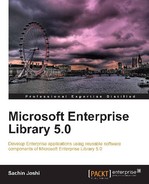Book Description
Develop Enterprise applications using reusable software components of Microsoft Enterprise Library 5.0
Develop Enterprise Applications using the Enterprise Library Application Blocks
Set up the initial infrastructure configuration of the Application Blocks using the configuration editor
A step-by-step tutorial to gradually configure each Application Block and implement its functions to develop the required Enterprise Application
In Detail
Microsoft Enterprise Library is a collection of reusable software components (also known as Application Blocks) that are designed to assist developers with common enterprise development challenges. Before using an Application block, you should have a good understanding of your application requirements and of the scenarios that the Application Block is designed to address.
This book covers the fundamental elements of each Application Block so that you get a good understanding of its concepts. This is followed by referencing the required and optional assemblies and the initial configuration of that block using the configuration editor. Finally, leverage Application Block features to achieve goals of the enterprise application development.
You will first get an overview of the different Application Blocks in Enterprise Library and their inter-dependencies. Then you will learn to install the Enterprise library and optionally the source code. Then you will learn about the individual functional Application Blocks: the Data Access Application Block, Logging Application Block, Exception Handling Application Block, Caching Application Block, Validation Application Block, Security Application Block, and Cryptography Application Block.
In the Caching Application Block chapter you will learn to reference the required assemblies, configure the initial settings, cache, retrieve, remove, and flush cached data. You will also learn to configure and leverage encryption providers to encrypt cached data.
In the Validation Application Block chapter you will be introduced to concepts such as Validators, ValidatorFactory, ValidationResults, and so on. You will learn to reference the required assemblies, set up the initial configuration, validate objects using attributes, validate values programmatically, validate using configuration, and also learn to integrate the Application block with Windows Forms and ASP.NET. Finally you will learn to implement a custom validator.
In the Security Application Block chapter you will be introduced to Authorization Providers and the Security Cache Provider. You will then learn about referencing required assemblies, configure security settings, and learn to set up and validate based on the authorization rules. You will also learn to leverage the Security cache provider to cache user Identity, Principal, and Profile. Finally you will learn to implement a custom Authorization Provider.
In the Cryptography Application Block chapter you will be introduced to Hashing and Cryptography providers; you will learn to reference required assemblies, set up the initial configuration, generate/compare hash values, and implement a custom hash provider. You will also learn to encrypt/decrypt data and also implement a custom symmetric cryptography provider.
A step by step tutorial that guides you through the process of building Enterprise applications using the Application Blocks in Microsoft Enterprise Library 5.0.
Table of Contents
- Microsoft Enterprise Library 5.0
- Microsoft Enterprise Library 5.0
- Credits
- About the Author
- Acknowledgement
- About the Reviewers
- Preface
- 1. Getting Started with Enterprise Library
- 2. Data Access Application Block
- Working of Data Access Application Block
- Developing an application
- Retrieving records using ExecuteReader
- Retrieving records using DataSet
- Retrieving a record as an object
- Retrieving multiple records as an object collection
- Retrieving records as XML
- Executing a command using ExecuteNonQuery
- Retrieving scalar values
- Updating records using DataSet
- Working with transactions
- Summary
- 3. Logging Application Block
- Developing an application
- Exploring design elements
- LogEntry
- Logger
- LogWriter
- Adding trace source categories
- Configuring trace listeners
- Configuring Event Log Trace Listener
- Configuring Flat File Trace Listener
- Configuring Rolling Flat File Trace Listener
- Configuring XML Trace Listener
- Configuring Database Trace Listener
- Configuring to send log messages to an e-mail address
- Configuring System Diagnostics Trace Listener
- Configuring Message Queuing Trace Listener
- Configuring WMI Trace Listener
- Configuring custom trace listeners
- Configuring log message formatters
- Configuring logging filters
- TraceManager and Tracer
- Customizing Logging block elements
- Summary
- 4. Exception Handling Application Block
- Developing an application
- Wrapping an exception using Wrap handler
- Replacing an exception using Replace handler
- Logging an exception using Logging handler
- WCF fault contract exception handler
- Implementing custom exception handler
- Summary
- 5. Caching Application Block
- Developing an application
- Reloading expired items
- Configuring Isolated Cache Storage Backing Store
- Configuring Database Cache Storage
- Configuring and encrypting cached data
- Summary
- 6. Validation Application Block
- Validation Application Block features
- Developing an application
- Understanding Validators
- Understanding Rule Sets
- Understanding ValidatorFactory
- Understanding ValidationResults
- Validating objects using attributes
- Validating values programmatically
- Validating objects using self-validation
- Validating objects using configuration
- Integrating with Windows Forms-based applications
- Integrating the Validation block with ASP.NET
- Implementing a Custom Validator
- Summary
- 7. Security Application Block
- Developing an application
- Implementing a custom Authorization Provider
- Summary
- 8. Cryptography Application Block
- Developing an application
- Working of Hash Provider
- Working of symmetric cryptography providers
- Summary
